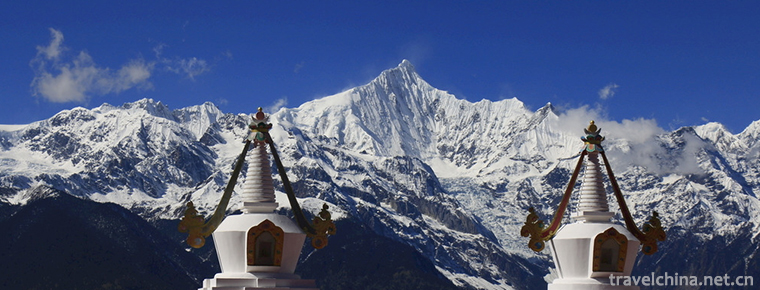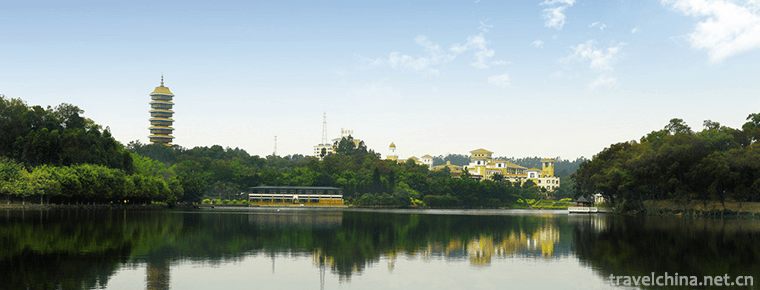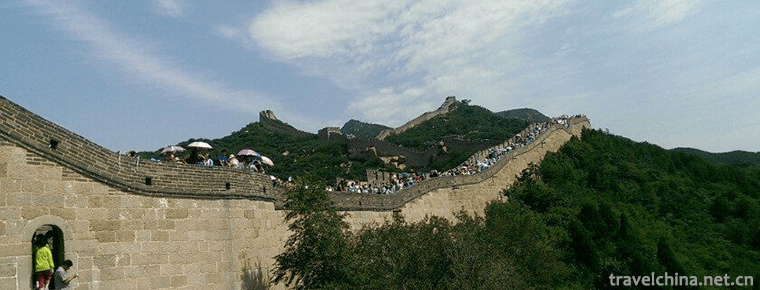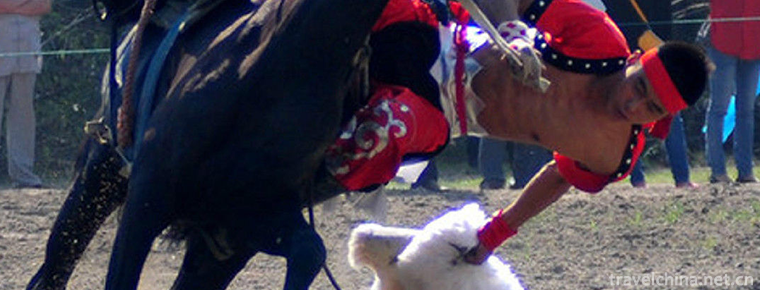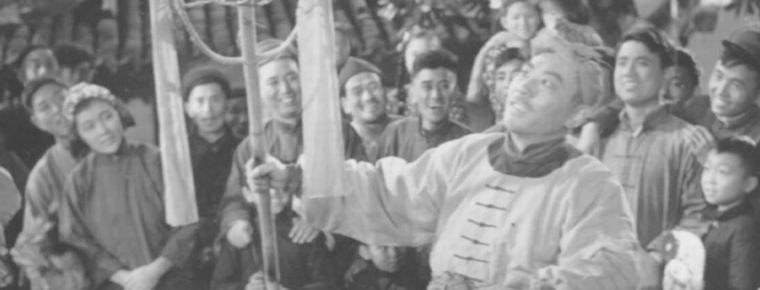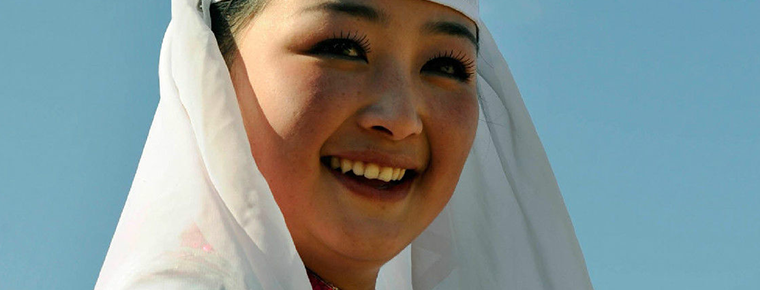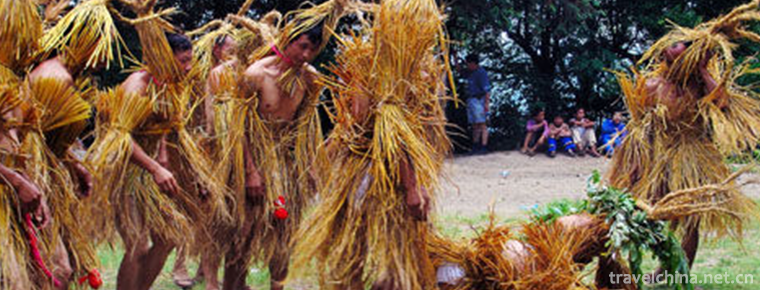Huangdi Mausoleum Scenic Area
Huangdi Mausoleum is the tomb of Xuanyuan Huangdi, the ancestor of the Chinese nation. It is the only Huangdi Mausoleum recorded in Historical Records. It is the first batch of national key cultural relics protection units, the first batch of national AAAAA-level tourist attractions, national scenic spots and scenic spots, and the first batch of national patriotic education demonstration bases . It is known as "the first mausoleum in the world" , also known as "the first mausoleum in China" , "the first mausoleum in China" . Located in North Qiaoshan, Huangling County, Yan'an City, Shaanxi Province.
The Mausoleum of the Yellow Emperor, known as the Bridge Mausoleum in ancient times, is a place where emperors and celebrities worship the Yellow Emperor. The earliest sacrifice to the Yellow Emperor in history began in the three years of Qin Linggong (422 years ago). Qin Linggong "served as Wuyang Shangdu, dedicated to the Yellow Emperor" . Since Emperor Wudi of the Han Dynasty led 180,000 troops to worship the Mausoleum of the Yellow Emperor in the first year of Yuanfeng (110 years ago), Qiaoshan has been the place where all dynasties held national sacrifices, preserving all kinds of cultural relics from the Han Dynasty to the present.
The ancient cypress group in Huangdiling Mausoleum is the oldest, the largest and the most complete preserved group in China, with a total of more than 80,000 plants and more than 30,000 plants over a thousand years. "The Yellow Emperor planted cypress by hand" is more than five thousand years ago. It is said that it was planted by the Yellow Emperor himself. It is the oldest cypress tree in the world . It is known as "the father of cypress in the world" and "the crown of cypress in the world".
In March 1961, the Mausoleum of the Yellow Emperor was announced by the State Council as the first batch of key cultural relics protection units nationwide, and was designated as "No. 1 ancient tomb" . In July 1997, it was announced by the Ministry of Propaganda as the first national demonstration bases for patriotic education . In May 2002, it was listed as a national scenic spot . In May 2007, it was listed as the first national AAAAA class tourist attractions.
In 2006, the Qing and Ming Dynasty official ceremony of Xuanyuan Huangdi (Huangdi Mausoleum Ceremony) was listed in the first batch of national intangible cultural heritage list. In November 2013, Shaanxi Province launched the "Yellow Emperor Mausoleum Festival" to declare the list of world intangible cultural heritage . In August 2014, the Mausoleum of the Yellow Emperor was listed in the project of declaring world cultural heritage.
Shaanxi is the root of the nation, Yan'an is the soul of the nation, and the Mausoleum of the Yellow Emperor is the spiritual symbol of Chinese civilization.
geographical environment
Qiaoshan, where Huangdi Mausoleum is located, is about one kilometer north of Huangling County, Shaanxi Province. It is part of the eastern extension of the Meridian Mountains. The meridian ridge runs north and south, the north is Zi, the south is noon, so it is called meridian ridge. The total area of Qiaoshan is 566.7 hectares. The mountain is thick and magnificent, and the depression water circulates on three sides . The mountains are densely forested, with an area of 89.1 hectares covered by ancient cypresses. There are more than 81600 ancient cypresses, of which more than 30,000 are over a thousand years old. They are the oldest, largest and most complete group of ancient cypresses in China.
Song Yushi's Taiping Huanyu Ji contains: "Qiaoshan, Shanhai Jing cloud:"Pugu water source under its mountain, water flow, so it is called Qiaoshan." "Reading Records of History and Local Opinions" written by Gu Zuyu of Qing Dynasty contains: "Jushui goes to the north of the county and crosses the mountain because of the name of the bridge."
Juhe River passes around Qiaoshan in U shape from west to east. Looking down from the mountain, there are rivers in the East and rivers in the west, just as water passes through the bottom of the mountain. Therefore, the famous Qiaoshan Mountain and Huangdi Mausoleum are named Qiaoling because of the mountain.
On July 11, 1992, People's Daily published an article entitled "Fengshui Axis of Huangdi Mausoleum". The article said: "The Fengshui Axis of Huangdi Mausoleum is from the main ridge of Qiaoshan Mountain to the tomb of Huangdi Mausoleum, and forms a connecting line with the peak of Yintai Mountain. All kinds of buildings in Huangdi Mausoleum area are built on this axis, and the direction of the tomb is just on this line." This line is northwest to southeast. That is to say, the mausoleum of Huangdi Mausoleum is sitting in the north and South (north to south) or west to East (west to east), which is different from that of later emperors. It is based on geography, with its back to northwest and face to southeast, and completely coincides with the direction of Qiaoshan, Ziwuling and Kunlun Mountain, known as Longmai. That is to say, the basic form of China's geography - "Tilting northwest, Dibu is not" Southeast of China
"Records of History, Volume I, Five Emperors First Book" contains: "The Yellow Emperor collapsed, buried Qiaoshan".
In ancient times, Qiaoshan was the residence of Jiyio clan, which was called Pingshan; in Huangdi period, it was called Xuanyuan Qiu or Xuanyuan Tai. Huangdi was named Xuanyuan, and the palace in Huangdi City was located here, which later evolved into Qiaoshan. After the Yellow Emperor united with Emperor Yan to defeat Chiyou, the leader of the Chinese tribal alliance became the co-owner of the world, which made the Chinese nation enter the civilized era from the barbaric era, and the great achievements of the Yellow Emperor were naturally admired and worshipped by later generations. After the death of Emperor Huangdi, in order to express the feelings of remembrance for this primitive human ancestor, people built tombs in Qiaoshan and offered sacrifices to temples. In the thousands of years after the death of the Yellow Emperor, the activities of sacrificing the Yellow Emperor in successive dynasties never stopped. From Yu, Xia, Shang, Zhou to Qin, Han, Sui, Tang, Song, Yuan, Ming and Qing dynasties, the Yellow Emperor was sacrificed as an ancestor, except for the "god" and "emperor" sacrifices in some periods.
After the first emperor of Qin Dynasty swept away the six countries and unified the world, it was stipulated that the tombs of the emperor of heaven should be called "mausoleums" and the common people's tombs should be called "tombs". The Han Dynasty also stipulated that there must be "temples" beside the mausoleum of the emperor. At the beginning of the establishment of the Han Dynasty, Liu Bang, the emperor of the Han Dynasty, promulgated an imperial edict to the world - "I highly respect ancestral halls and worship them." Today, the sacrifices of God and the worshippers of the gods of mountains and rivers have built "Xuanyuan Temple" at the foot of Qiaoshan . Afterwards, Emperor Wudi of the Han Dynasty offered sacrifices to the Mausoleum of the Yellow Emperor in person, which was recorded in the twelfth anniversary of the twelfth anniversary of History, Volume 12, Xiaowu, and in the sixth anniversary of the anniversary of Buddhism, Volume 28, the sixth anniversary of the anniversary of Buddhism. It was in the northern part of Sui Dynasty that he visited Shuofang and drew more than 100,000 troops. He also offered sacrifices to the Yellow Emperor's mound and bridge hill. In the winter of the first year of Yuanfeng (110 years ago), Emperor Wudi of Han Dynasty led 100,000 tours to the north of Shuofang. When he returned, he came to Qiaoshan to worship the tomb of Huangdi. This is the first record of the Mausoleum of the Yellow Emperor in the official history.
Since the Tang and Song Dynasties, the emperors of all dynasties have paid more attention to it, and constantly renovated and added soil, which has increased the number of tombs.
In the fifth year (770) of the Tang Dynasty's Zong Dali period, Zang Xirang, an envoy of the Bianfang Festival, played a prelude: "There is Xuanyuan Huangdi Mausoleum in Fangzhou, please buy temples and enjoy sacrifices at four o'clock, listed in the sacrificial rites". With the approval of the Daizhong Emperor, the Tang Dynasty began a two-year large-scale renovation campaign in Qiaoling Mausoleum to build the Huangdi Temple and plant 1140 cypress trees. Since then, the sacrifice to the Yellow Emperor has been upgraded to a national ceremony, and Qiaoling has become the only official designated place to worship the Yellow Emperor. This not only helps to standardize sacrificial rites, but also plays an objective role in strengthening political domination and cultural identity. After the wars of the late Tang and the Five Dynasties, the mausoleums of the previous emperors, including the Huangdi Mausoleum, had already appeared the situation of "woodcutting can not help". But the sacrificial buildings "destroyed" make the normal sacrificial activities impossible. For this reason, Zhao Kuangxu, Taizu of the Song Dynasty, took office in the first year of Jianlong and the first two years of QianDe, stipulating that Huangdi Mausoleum and Yandi, Gaoxin, Tang Yao, Yu Shun and Xia Yu Mausoleums should have five mausoleums each, and that Spring and Autumn Ancestral Halls should be held in a prison and that the destroyers should repair them. In the second year of Kaibao, because of the erosion of Juhe River, cliff collapses and water avalanches often occurred at the foot of Qiaoshan Mountain, threatening the survival of temples and courtyards. Local officials wrote to the court and Song Taizu issued a decree to move Xuanyuan Temple from the foot of Qiaoshan Mountain to the Huangdi Palace at the foot of Qiaoshan Mountain, which is the present site.
In the six years of Song Jiayou (1061), Zhao Zhenxia, the emperor of Song Renzong, ordered the local officials of Fangzhou (now Huangling County) to mobilize the people of Li to plant more than 1400 cypress trees in that year. At the same time, three families were selected to exempt from all shaking duty and specially care for and plant cypress trees in Qiaoshan. This is the earliest official document on the protection of the Huangdi Mausoleum.
In the second year of Yuantaiding (1325), Emperor Yuantaiding promulgated the decree of protecting Huangdi Mausoleum Temple, and inscribed the Imperial Tablet of Prohibiting Tree Cutting in Huangdi Mausoleum. It recorded that Emperor Yuantaiding issued the decree of protecting Xuanyuan Temple building and forbidding tree cutting in Qiaoling Mausoleum, and exempted the palace view, the local tax and commercial tax of the temple, which increased the penalty to those who destroyed Qiaoling Mausoleum. The monument is also the only monument on the Mausoleum of the Yellow Emperor in the Yuan Dynasty in China. It is a valuable material material for studying the Mausoleum of the Yellow Emperor in the Song and Yuan Dynasties. From Yuan Huizong to the first year (1341), Yuan Huizong decreed to rebuild the life preservation Palace on the west side of Xuanyuan Temple, which was burned by fire. The Huangdi Mausoleum in Qiaoshan was listed as a national sacrifice in the Ming Dynasty, and the sacrifice never stopped.
Historical evolution
In the third year of Hongwu, the emperor of the Ming Dynasty, Zhu Yuanzhang, the emperor of the Ming Dynasty, offered sacrifices to the emperor and renovated the mausoleum Temple of the emperor. At the same time, he set up two five-grade mausoleum guardians in Xuanyuan Temple, who were later concurrently appointed by county decrees. This practice was followed by later generations, and the county decree and mausoleum Guardian became the system. Zhu Yuanzhang not only arranged ministers to worship the Yellow Emperor on behalf of himself, but also elevated the administrative level of the local government. Most of the county orders in the Ming Dynasty were seven grades. Because the county orders in the central part of the country had to serve as guardians of the Huangling Mausoleum concurrently, they were treated according to the five grades. In the seventh year of Hongwu (1374), the statue of Emperor Xuanyuan was built; in the forty-second year of Jiajing (1563), Emperor Zhu Houyun of Ming Dynasty renovated the Xuanyuan Temple; in the autumn of 1621, Emperor Zhu of Ming Dynasty renovated the Mausoleum of Emperor Huangdi by school; in the ninth year of Chongzhen (1636), the governor of Zhongxian County renovated the Mausoleum of Emperor Huangdi. In the Ming Dynasty, there were 21 memorials of Zhu inscriptions of the imperial system.
In the third year of Shunzhi (1646), the emperor Shunzhi of the Qing Dynasty ordered his envoys to sacrifice to the Mausoleum of the Yellow Emperor, and repaired the Mausoleum of the Yellow Emperor for the first time in the Qing Dynasty. Since then, emperors Kangxi, Yongzheng, Qianlong, Jiaqing and Daoguang have sent people to the Huangdi Mausoleum in Qiaoshan, carrying out more than thirty sacrificial activities and nine major repairs. Among them, there were three repairs in Kangxi, two in Yongzheng, one in Qianlong, one in Jiaqing and two in Daoguang. Following the system of Ming Dynasty, the sacrifices to Huangdi Mausoleum in Qing Dynasty were generally three-year-long sacrifices, mostly by commissioners sent by the emperor. The ceremonies were more solemn and magnificent. In addition to the regular sacrifices, special sacrifices were added when the emperor ascended the throne, the queen's birthday, the flood and drought disasters, the grain harvest was plentiful and the border disasters were eliminated. During the reign of Qianlong, Bi Yuan, governor of Shaanxi Province, inscribed the tomb "The Tomb of Huangdi Bridge at Guxuanyuan" in front of the tomb. Since then, Qiaoling has become more famous.
After the founding of the Republic of China, in March of the first year of the Republic of China (1912), Dr. Sun Yat-sen appointed important officials to dedicate a special trip to the Mausoleum of the Yellow Emperor, and personally wrote sacrificial essays to praise the "five thousand years since the founding of China, Shenzhou Xuanyuan autobiography, the creation of a guide car, calming Chiyou chaos, world civilization, only I first", reflecting a strong sense of national self-confidence and pride. After the September 18th Incident, Japanese imperialism intensified its war of aggression against China. In order to unite the people of the whole country in the common war of resistance and to unite with the outside world, patriots from all over the country have proposed the rite of sweeping the graves of the nation. In April, 1934, the Central Committee of the Kuomintang and the National Government of the People's Republic of China offered sacrifices to the Mausoleum of the Yellow Emperor, and determined that the annual Tomb Sweeping Festival of the Qingming Dynasty was "National Tomb Sweeping Festival" and that the Tomb of the Yellow Emperor was sacrificed to the public. In the same year, Jianling Road was rebuilt and opened to traffic. On the Qingming Festival in 1937, representatives of the Kuomintang and the Communist Party of China went to the Tomb of the Yellow Emperor for a joint Memorial service. Mao Zedong personally wrote The Mausoleum of the Yellow Emperor, declaring that "the national front, the best way to save the nation, 40,000 people, resolutely resist", became a solemn oath to declare ancestors, unite against foreign aggression, and establish the national anti-Japanese United front. In 1939, the Shaanxi Provincial Government urgently ordered the establishment of the Huangdi Mausoleum Temple Management Institute, the director of which was concurrently appointed by the central county magistrate. In the autumn of the same year, the construction and maintenance of the Huangdi Mausoleum Temple was started. All the gates, palaces, fences and scarce people were among the repairs, while the "system of worshiping hong" was still waiting. The next March, the renovation was completed. In the thirty-first year of the Republic of China (1942), the Commissioner's Office of the Third Administrative Supervision District of Shaanxi Province changed the Bridge Mausoleum to Huangdi Mausoleum in order to distinguish it from Tang Ruizhong's Mausoleum in Fengshan, Pucheng, Shaanxi Province. Since then, Huangdi Mausoleum has been used to this day. In the winter of the 31st year of the Republic of China (1942), Chiang Kai-shek, chairman of the Central Committee of the Kuomintang, inscribed three big words, "The Mausoleum of the Yellow Emperor" and ordered people to lay a stone tablet before the Mausoleum of the Yellow Emperor. In the thirty-second year of the Republic of China (1943), in order to renovate the Huangdi Mausoleum Temple, the Huangdi Mausoleum Construction Committee was established, donations were raised to the society, and the Huangdi Temple Hall was expanded. In the most arduous 193 years of the Anti-Japanese War (1944), the National Government renamed the central county Huangling County, which highlighted the unique status of the Huangdi Mausoleum.
After the founding of New China, Chairman Mao Zedong personally instructed Premier Zhou Enlai to arrange for the maintenance and protection of the Huangdi Mausoleum, and entrusted Comrade Guo Moruo to inscribe the "Huangdi Mausoleum" monument. From 1959 to 1961, the Shaanxi Provincial People's Government allocated funds to renovate the Huangdi Temple Hall; in 1962, the Huangdi Mausoleum was listed by the State Council as the first batch of key cultural relics protection units in the country; in 1964, the pavilions and gates were renovated; and in 1976, the Cultural Bureau of the Shaanxi Revolutionary Committee allocated funds to renovate the hilltop sacrificial hall, the Huangdi Temple Hall and the wall. Since 1978, the Huangdi Tomb has been listed as a key maintenance and renovation unit in Shaanxi Province, and two phases of construction have been carried out in 1984 and 1987.
Since the 1980s, a large number of compatriots from Hong Kong, Macao and Taiwan and overseas Chinese have traveled thousands of miles to Qiaoshan to worship the Mausoleum of the Yellow Emperor. In 1988, Deng Xiaoping, Chairman of the Military Commission of the Central Committee of the Communist Party of China, inscribed "descendants of the Yellow Emperor". Since 1992, the Huangdi Mausoleum has been renovated on a large scale in Shaanxi Province. On the Qingming Festival of 1993, Jiang Zemin, then General Secretary of the Central Committee of the Communist Party of China, President of the State and Chairman of the Central Military Commission, inscribed the inscription "Chinese civilization has a long history" for the Mausoleum of the Yellow Emperor. Every year since 1994, leaders of the state have come to Shaanxi to participate in public sacrifices. The supremacy, continuity and uniqueness of the Mausoleum of the Yellow Emperor in Shaanxi have been unanimously recognized by the descendants of Yan and Huang at home and abroad.
In 1998 and 2000, the monuments of the return of Hong Kong and Macao, written by the first Chief Executive of the Special Administrative Region, Dong Chee-hua and Ho Ho-bak, were successively completed at the Mausoleum of the Yellow Emperor. They are an interpretation of the traceable cultural identity and a centripetal force for the great rejuvenation of the Chinese nation.













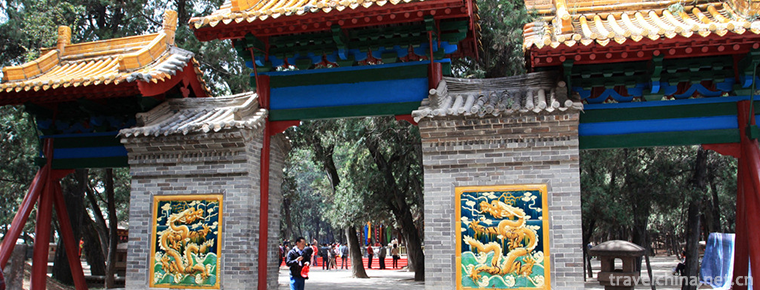
-
Meili Snow Mountain
Meili Snow Mountain, located in the eastern part of Chayu County, Tibet, and the western part of Jingyunling Township, Deqin County, Diqing Tibetan Autonomous Prefecture, Yunnan Province.
Views: 186 Time 2018-11-13 -
Xiangsha Bay Scenic Spot in Dalat Banner Ordos
Xiangsha Bay was opened as a tourist attraction in January 1984, listed as a national line scenic spot by the National Tourism Administration in 1991.
Views: 240 Time 2018-11-29 -
sanshui forest park
Sanshui Forest Park is located in the north suburb of the southwest town of Sanshui District, Foshan City, Guangdong Province..
Views: 142 Time 2018-12-18 -
Legend of Badaling Great Wall
Badaling Great Wall legend is one of the traditional folk legends in Beijing. It is rooted in the folk and has prominent dialect characteristics. It combines romanticism and realism skillfully..
Views: 214 Time 2019-04-02 -
Buzkashi
One of the folk sports events in Xinjiang, China. Although there is no written record of sheep on foot, it has been examined in some areas of northern Xinjiang, which has continued to this day, and is.
Views: 126 Time 2019-04-26 -
Shanghai Opera
Shanghai Opera, a local traditional drama in Shanghai, is one of the national intangible cultural heritage..
Views: 157 Time 2019-05-03 -
Hui Costume
The main symbol of Hui costume is the head. Men like to wear white caps. Hui women often wear a hood. Older Hui women wear black or brown headscarves in winter .
Views: 112 Time 2019-05-04 -
Firing Techniques of Liling Unglazed Colorful Porcelain
The firing technology of Liling Unglazed Five-color Porcelain, the local traditional firing technology of Liling Unglazed Five-color Porcelain in Hunan Province, is one of the national intangible cult.
Views: 165 Time 2019-05-13 -
PuXian opera
Puxian Opera is one of the oldest operas in China. It originated in Tang Dynasty, became in Song Dynasty and flourished in Ming and Qing Dynasty. It is known as the "living fossil" of Southe.
Views: 116 Time 2019-06-09 -
Maogus Dance of Tujia Nationality in Western Hunan
Maogus Dance of Tujia Nationality in Western Hunan Province, the traditional dance of Tujia and Miao Autonomous Prefecture in Western Hunan Province, is one of the national intangible cultural heritag.
Views: 175 Time 2019-07-06 -
Mineral resources in Leshan
Leshan City is rich in mineral resources, 34 kinds of mineral resources have been proved, especially non-metallic minerals, with great development potential. Among them, the total amount of proven rock salt resources is 10.5 billion tons, with an annual.
Views: 151 Time 2020-12-17 -
Nanchong scenic spot
The national 5A tourist attraction is located in Ma'an Town, Yilong County, with a total planning area of 52.5 square kilometers. The core scenic area with the former residence of Zhu De, the birthplace of Zhu De and the memorial hall of former residence of Comrade .
Views: 317 Time 2020-12-17
